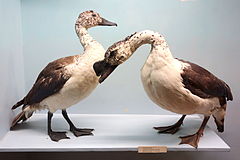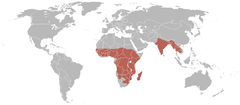Knob-billed duck
| Knob-billed duck | |
|---|---|

| |
| Sarkidiornis melanotos (female, male) | |
| Scientific classification | |
| Kingdom: | |
| Phylum: | |
| Class: | |
| Order: | |
| Family: | |
| Subfamily: | |
| Genus: | Sarkidiornis Eyton, 1838
|
| Species: | S. melanotos
|
| Binomial name | |
| Sarkidiornis melanotos (Pennant, 1769)
| |
| Subspecies | |
|
S. m. melanotos (Pennant, 1769) | |

| |
| Global range | |
| Synonyms | |
|
Anser melanotos Pennant, 1769 | |
The knob-billed duck (Sarkidiornis melanotos), or comb duck, is an unusual, pan-tropical duck, found in tropical wetlands in sub-Saharan Africa, Madagascar and south Asia from Pakistan to Laos and extreme southern China. It also occurs in continental South America south to the Paraguay River region in eastern Paraguay, southeastern Brazil and the extreme northeast of Argentina,[2] and as a vagrant on Trinidad.
It is the only known species of the genus Sarkidiornis. The supposed extinct "Mauritian comb duck" is based on misidentified remains of the Mauritian shelduck (Alopochen mauritianus); this was realized as early as 1897,[3] but the mistaken identity can still occasionally be found in recent sources.
Description and systematics
This common species is unmistakable. It is one of the largest species of duck. Length can range from 56 to 76 cm (22 to 30 in), wingspan ranges from 116 to 145 cm (46 to 57 in) and weight from 1.03 to 2.9 kg (2.3 to 6.4 lb).[4][5][6] Adults have a white head freckled with dark spots, and a pure white neck and underparts. The upperparts are glossy blue-black upperparts, with bluish and greenish iridescence especially prominent on the secondaries (lower arm feathers). The male is much larger than the female, and has a large black knob on the bill. Young birds are dull buff below and on the face and neck, with dull brown upperparts, top of the head and eyestripe.[7][8]
Immature knob-billed ducks look like a large greyish female of the cotton pygmy goose (Nettapus coromandelicus) and may be difficult to tell apart if no other birds are around to compare size and hue. If seen at a distance, they can also be mistaken for a fulvous whistling-duck (Dendrocygna bicolor) or a female maned duck (Chenonetta jubata). The former is more vividly colored, with yellowish and reddish brown hues; the latter has a largely dark brown head with white stripes above and below the eye. However, knob-billed ducks in immature plumage are rarely seen without adults nearby and thus they are usually easily identified too.[7]
The knob-billed duck is silent except for a low croak when flushed.[8]
There are two easily distinguished subspecies.,[7] in fact, some taxonomists consider them to be distinct species:
- Knob-billed duck (Sarkidiornis melanotos melanotos) (Pennant, 1769) (also called nakta in South Asia[9]) or Old World knob-billed duck (Sarkidiornis melanotos melanotos) from the Old World
- Larger; flanks lighter (light grey, in females sometimes whitish)
- Comb duck (Sarkidiornis melanotos sylvicola) (Ihering & Ihering, 1907) from South America
- Smaller; flanks darker (black in males, medium grey in females).
-
Male knob-billed duck
-
Female knob-billed duck
-
Male South American knob-billed duck (S. m. sylvicola)
-
Female comb duck
-
Female comb duck
Uncertainty surrounds the correct systematic placement of this species. Initially, it was placed in the dabbling duck subfamily Anatinae. Later, it was assigned to the "perching ducks", a paraphyletic assemblage of waterfowl most of which are intermediate between dabbling ducks and shelducks. As the "perching ducks" were split up, the knob-billed duck was moved to the Tadorninae or shelduck subfamily.[7] In addition, Some taxonomists separate the two subspecies into distinct species.
Analysis of mtDNA sequences of the cytochrome b and NADH dehydrogenase subunit 2 genes, however, suggests that it is a quite basal member of the Anatidae, vindicating the earliest placement. But its closest living relatives cannot be resolved to satisfaction without further study.[10]
Ecology
It breeds in still freshwater swamps and lakes in the tropics. It is largely resident, apart from dispersion in the wet season.[7]
This duck feeds on vegetation by grazing or dabbling[7] and to a lesser extent on small fish, invertebrates, and seeds. It can become a problem to rice farmers. Knob-billed ducks often perch in trees. They are typically seen in flocks, small in the wet season, up to 100 in the dry season. Sometimes they separate according to sex.[8][11]
The knob-billed duck is declining in numbers locally, but due to its wide range it is not considered globally threatened by the IUCN.[1] It is one of the species to which the Agreement on the Conservation of African-Eurasian Migratory Waterbirds applies.
Reproduction
African birds breed during and after the rainy season and may not breed if the rain is scanty. Knob-billed ducks nest mainly in tree holes,[7] also in tall grass. They line their nests with reeds, grass, or feathers, but not down.[11]
Males may have two mates at once or up to five in succession. They defend the females and young but not the nest sites. Unmated males perch in trees and wait for opportunities to mate.[11]
Females lay 7 to 15[7] yellowish-white eggs. Several females may lay in a single "dump nest" containing up to 50 eggs.[11]
References
- ^ a b Template:IUCN
- ^ Bencke, Glayson Ariel (2007): Avifauna atual do Rio Grande do Sul, Brasil: aspectos biogeográficos e distribucionais ["The Recent avifauna of Rio Grande do Sul: Biogeographical and distributional aspects"]. Talk held on 22 June 2007 at Quaternário do RS: integrando conhecimento, Canoas, Rio Grande do Sul, Brazil. PDF abstract
- ^ Andrews, C.W. (1897). "On some fossil remains of Carinate birds from central Madagascar". Ibis. 7 (3): 343–359. doi:10.1111/j.1474-919X.1897.tb03281.x.
- ^ Ogilvie & Young, Wildfowl of the World. New Holland Publishers (2004), ISBN 978-1-84330-328-2
- ^ Hilty, Steven L. (2002). Birds of Venezuela. Princeton University Press. pp. 197–. ISBN 978-1-4008-3409-9.
- ^ Sarkidiornis melanotos (Comb duck, Knob-billed duck). biodiversityexplorer.org
- ^ a b c d e f g h Madge, Steve & Burn, Hilary (1987): Wildfowl: an identification guide to the ducks, geese and swans of the world. Christopher Helm, London. ISBN 0-7470-2201-1
- ^ a b c Zimmerman, Dale A.; Turner, Donald A., & Pearson, David J. (1999): Birds of Kenya and Northern Tanzania. Princeton University Press, Princeton. ISBN 0-691-01022-6
- ^ Presumably after naak meaning nose. E. H. Johnston (1936) Bird-Names in the Indian Dialects. Bulletin of the School of Oriental Studies 8(2/3):599-601.
- ^ Johnson, Kevin P. & Sorenson, Michael D. (1999). PDF "Phylogeny and biogeography of dabbling ducks (genus: Anas): a comparison of molecular and morphological evidence". Auk. 116 (3): 792–805. doi:10.2307/4089339.
{{cite journal}}: Check|url=value (help)CS1 maint: multiple names: authors list (link) - ^ a b c d Honolulu Zoo (2007): Comb Duck. Retrieved 2007-06-08.






